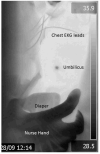A pilot study to examine maturation of body temperature control in preterm infants
- PMID: 24004312
- PMCID: PMC3783951
- DOI: 10.1111/1552-6909.12240
A pilot study to examine maturation of body temperature control in preterm infants
Abstract
Objective: To test instrumentation and develop analytic models to use in a larger study to examine developmental trajectories of body temperature and peripheral perfusion from birth in extremely low-birth-weight (EBLW) infants.
Design: A case study design.
Setting: The study took place in a Level 4 neonatal intensive care unit (NICU) in North Carolina.
Participants: Four ELBW infants, fewer than 29 weeks gestational age at birth.
Methods: Physiologic data were measured every minute for the first 5 days of life: peripheral perfusion using perfusion index by Masimo and body temperature using thermistors. Body temperature was also measured using infrared thermal imaging. Stimulation and care events were recorded over the first 5 days using video which was coded with Noldus Observer software. Novel analytical models using the state space approach to time-series analysis were developed to explore maturation of neural control over central and peripheral body temperature.
Results/conclusion: Results from this pilot study confirmed the feasibility of using multiple instruments to measure temperature and perfusion in ELBW infants. This approach added rich data to our case study design and set a clinical context with which to interpret longitudinal physiological data.
Keywords: Body Temperature Regulation; Hypothermia; Neonatal; Physiological Processes; Pilot Projects.
© 2013 AWHONN, the Association of Women's Health, Obstetric and Neonatal Nurses.
Figures





Similar articles
-
Optimal body temperature in transitional extremely low birth weight infants using heart rate and temperature as indicators.J Obstet Gynecol Neonatal Nurs. 2010 Jan-Feb;39(1):3-14. doi: 10.1111/j.1552-6909.2009.01087.x. J Obstet Gynecol Neonatal Nurs. 2010. PMID: 20409098 Free PMC article.
-
Comparison of two microenvironments and nurse caregiving on thermal stability of ELBW infants.Adv Neonatal Care. 2002 Jun;2(3):149-60. doi: 10.1053/adnc.2002.33543. Adv Neonatal Care. 2002. PMID: 12903226 Clinical Trial.
-
Improving admission temperature in extremely low birth weight infants: a hospital-based multi-intervention quality improvement project.J Perinat Med. 2013 Jul;41(4):455-60. doi: 10.1515/jpm-2012-0259. J Perinat Med. 2013. PMID: 23334053
-
Optimizing the neonatal thermal environment.Neonatal Netw. 2006 Jul-Aug;25(4):251-60. doi: 10.1891/0730-0832.25.4.251. Neonatal Netw. 2006. PMID: 16913236 Review.
-
The effect of thermoregulation quality improvement initiatives on the admission temperature of premature/very low birth-weight infants in neonatal intensive care units: A systematic review.J Spec Pediatr Nurs. 2020 Apr;25(2):e12286. doi: 10.1111/jspn.12286. Epub 2020 Jan 7. J Spec Pediatr Nurs. 2020. PMID: 31909894
Cited by
-
Negative Temperature Differential in Preterm Infants Less Than 29 Weeks Gestational Age: Associations With Infection and Maternal Smoking.Nurs Res. 2017 Nov/Dec;66(6):442-453. doi: 10.1097/NNR.0000000000000250. Nurs Res. 2017. PMID: 29095375 Free PMC article.
-
Body temperature in premature infants during the first week of life: Exploration using infrared thermal imaging.J Therm Biol. 2017 Oct;69:118-123. doi: 10.1016/j.jtherbio.2017.06.005. Epub 2017 Jun 15. J Therm Biol. 2017. PMID: 29037371 Free PMC article.
-
Surface Body Temperature of Full-Term Healthy Newborns Immediately after Birth-Pilot Study.Int J Environ Res Public Health. 2019 Apr 12;16(8):1312. doi: 10.3390/ijerph16081312. Int J Environ Res Public Health. 2019. PMID: 31013692 Free PMC article.
-
Perfusion Index in Very Low Birth Weight Premature Infants During Their First 2 Weeks of Life.Biol Res Nurs. 2017 Jan;19(1):45-52. doi: 10.1177/1099800416656914. Epub 2016 Jul 26. Biol Res Nurs. 2017. PMID: 27352610 Free PMC article.
-
Thermal imaging applications in neonatal care: a scoping review.BMC Pregnancy Childbirth. 2019 Oct 24;19(1):381. doi: 10.1186/s12884-019-2533-y. BMC Pregnancy Childbirth. 2019. PMID: 31651266 Free PMC article.
References
-
- Agresti A. Categorical data analysis. 2nd ed John Wiley & Sons; Hoboken, New Jersey: 2002.
-
- Bekhet AK, Zauszniewski JA. Methodological triangulation: an approach to understanding data. Nurse Researcher. 2012;20:40–43. - PubMed
-
- Boros M, Takaichi S, Hatanaka K. Ischemic time-dependent microvascular changes and reperfusion injury in the rat small intestine. Journal of Surgical Research. 1995;59:311–320. - PubMed
Publication types
MeSH terms
Grants and funding
LinkOut - more resources
Full Text Sources
Other Literature Sources

